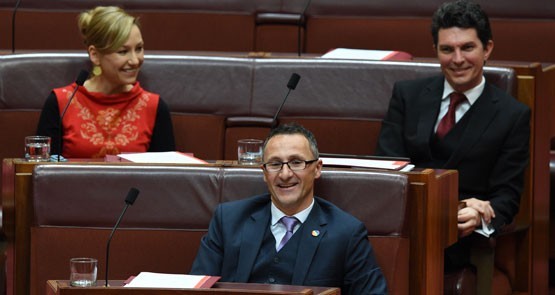
A popular standby at protest marches and demonstrations, particularly those associated with left-of-centre causes, is a two-stage chant in which attendees are invited to give voice first to the event’s objective, and then to the time frame in which they would like to see it fulfilled.
Answers to the first question — “what do we want?” — have ranged over the years from land rights and nuclear disarmament to same-sex marriage and an end to mandatory detention. But to the second question — “when do we want it?” — there can only ever be one answer: “NOW!”
The Greens’ recent form on the Senate voting system suggests their parliamentarians have perhaps spent too much time at such events over the years.
What the Greens want is electoral reform, and here at least they are in good company.
Bitter as much of the debate has been, there are few who don’t argue for change of some kind or another. Even Liberal Democratic Party Senator David Leyonhjelm, who been something of an intellectual leader of the micro-party cause, allowed that below-the-line voters should be allowed to have their votes exhaust after numbering at least six boxes.
The proposal the Greens have agreed to in conjunction with the Coalition and Nick Xenophon certainly aligns with their self-interest, since it would often eliminate threats to their lead candidates from micro-party preference snowballs.
The thrust of it has, nonetheless, generally been endorsed by distinterested authorities on the electoral system (though by no means all of them).
But in their determination to have it now, the Greens have essentially locked themselves in behind the political strategy of the Coalition, which could yet prove a bigger problem for them than they anticipated.
The reform process currently in train began in earnest just last month — nearly two years after the Joint Standing Committee on Electoral Matters brought down its post-election report on the subject, and just five months before it would have to be ready for action at a potential double dissolution election.
This reflects the government’s tactical interest in holding its cards close to its chest for as long as possible, so as to avoid alienating the crossbench any earlier than it had to.
It was with this base motive in mind that the timetable was set for Parliament to consider the most significant reform to itself in a generation.
The bill was shepherded through the House of Representatives in short order early last week, to be followed by a committee inquiry process that has been wrapped up just one week later.
The stage is now set for the passage of the legislation by the time the current parliamentary session ends in a fortnight, giving the Australian Electoral Commission enough time — or so it is hoped — to get its house in order in time for a July election, should the government indeed choose to go down that path.
As well as cleaning out the current Senate and replacing it with one the Coalition clearly expects would be more favourable to it, a double dissolution would also allow the government to pass legislation targeting trade unions, which has hitherto been blocked in the Senate.
At every step along this contentious path, the government is being enabled by support from the Greens – and in particular by its still new-ish leader, Richard Di Natale, of whom voters are still forming crucial early impressions.
Superficially at least, Greens supporters are taking a favourable view of the proposed reforms, if this week’s Essential Research poll is any guide.
After explaining the proposal to respondents in some detail, the poll founded that Greens voters — or an admittedly small sample of around 100 of them — approved of it by a margin of 46% to 29%.
However, a very different message emerged from another, larger sample Essential Research poll — this one conducted privately for the ACTU — which found 54% of Greens voters opposed to a deal with the government on Senate reform, with only 27.2% in favour.
Contradictory as these findings may appear at first, they in fact reflect a perfectly cogent view that the reforms are desirable in their own right, but that the Greens should not be pursuing them arm-in-arm with a Coalition that could, for all anyone knows, emerge in a few short months with enough Senate muscle to pass the kinds of measures that were blocked after the 2014 budget.
Bob Day, South Australian Family First Senator and a bitter opponent of the proposed reform, sought to drive a wedge through this gap in Greens sentiment last week by proposing the legislation be amended to give it a starting date of August 22 — early enough to take effect at the next election, but not if it’s a double dissolution.
This was rebuffed by Di Natale, who told the Financial Review the deadline would “create a situation where the Australian Electoral Commission would be preparing for a normal election under new rules, with the continued possibility of a double dissolution with the current rules”.
The distinction here would seem to be rather a fine one, given the quite considerable pressure the AEC will face in preparing for an election under the proposed new rules by early July.
It was perhaps a sign of the pressure the Greens are under that Di Natale was Wednesday hawking a “commitment” from the government that it would not hold a double dissolution election before July 1 — something it clearly never had any intention of doing in the first place.
The party is also confronting suggestions that the new system won’t even be to its own electoral advantage, at least in the short term.
Certainly a double dissolution would present the party with a headache in South Australia, where it would likely be reduced from two seats to one owing to competition from the Nick Xenophon ticket.
However, talk of the Greens going backwards needs to be kept in perspective. To hold its ground at the next election, the party will have to match its unprecedented success in winning six seats in 2010, which will be a tough task no matter when or how the election is held.
Recent polling trends give the Greens strong cause for optimism that they will at least be able to hold their ground outside South Australia, retaining their two seats apiece in Victoria, Western Australia and Tasmania, and one apiece in New South Wales and Queensland.
That, of course, assumes they are able to poll at their current strong level of support — something their lock-step approach with a conservative government on Senate reform, in the face of determined opposition on the Left from trade unions and other minor parties, could yet put at risk.








It’s completely rational to have an August 22 starting date for the new voting system in order to give the AEC time to set up the new system (although, with the AEC’s record it should probably be August 22, 2017).
I’ve come to like the proposed changes. I’m not so pleased that they’ll lead to an early election with a double dissolution.
Those Labbies bitching about the Greens siding with the Libbies. Let’s count the time they’ve back the COALition.
My understanding is that this will cement the Greens as the only major non-Lib/Lab party in the senate (Xenophon-like groups excluded), most likely giving them the balance of power.
Liberal-Greens alliances like this one are rational, and so is Di Natale’s thinking. I expect there will be lots more similar deals to come. Both parties have a common aim – to destroy Labor. Both also have wealthy voters as supporters – in fact the Greens can only ever win affluent lower house seats. And they’ve got their eyes fixed on Grayndler and Sydney.
Is part of this senate deal also a lower house preference swap to knock off Albo and Plibersek? Why not? Makes sense, and they could pull it off…
Kevin Bonham wrote an interesting article in response to the Australian’s attempts to portray Greens supporters as all wealthy here http://kevinbonham.blogspot.com.au/2015/04/godless-wealthy-greens-too-rich-by-half.html
Basically not everyone in these electorates is wealthy, and in the inner city ones there are many young people (a demographic that the Greens do well with) who are renters.
Also, is Ballina a particularly affluent electorate?
Why suppose that the Greens have done this deal to get something in return for these changes when the main point of it is something they have wanted (abolition of GVTs) even longer than the Liberals have?
And more generally these attempts to paint the Greens and Liberals in some sort of alliance tend to fall down if you look at the facts, e.g. Jeremy Buckingham compiled an analysis showing that the Greens have voted with the Coaltion on 6% of division in the current Senate, the ALP on 38% of them.
@Teddy
Affluent lower house seats like Ballina, Lismore, Braddon and Lyons..